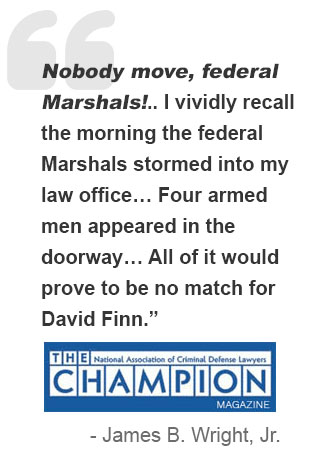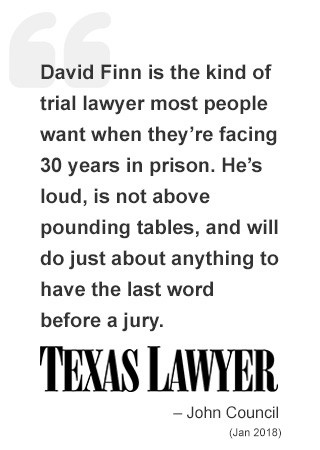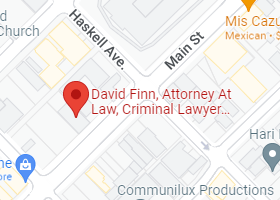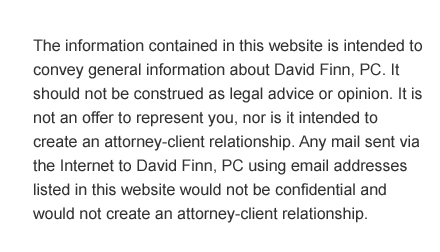


Confrontation Clause Alive & Well in Dallas
Note: There are some judges who actually believe that the Confrontation Clause to the United States Constitution does not apply to domestic violence cases. [Perhaps these judges can explain how to cross-examine hearsay].
Fortunately, the Dallas Court of Appeals begs to differ. Perhaps the Crawford case should be required reading for new judges. Last time I checked, Justice Scalia and the United States Supreme Court were a pretty good legal resource for trial courts.
DF
Court of Appeals of Texas,
Dallas.
Jett J. MASON, Jr., Appellant
v.
The STATE of Texas, Appellee.
No. 05-04-00451-CR.
June 13, 2007.
Background: Defendant was convicted in a jury trial in the Criminal Court No. 10, Dallas County, Lisa Fox, J., of misdemeanor assault. Defendant appealed.
Holdings: The Court of Appeals, Sue Lagarde, J. (Retired), held that:
(1) non-testifying complainant’s out-of-court statements to officer who responded to her 911 call were testimonial;
(2) non-testifying complainant’s out-of-court statements to officer who responded to her 911 call violated defendant’s confrontation clause rights; and
(3) error in admitting non-testifying complainant’s out-of-court statements was harmful.
Reversed and remanded.
*903 Scala D. Byers, Garland, for appellant.
Craig Watkins, Dallas County District Attorney, Johanna H. Kubalak, John R. Rolater, Jr., Laura Anne Coats, Assistant District Attorneys, Dallas, for state.
Before Justices MOSELEY, FRANCIS, and LAGARDE.FN1
FN1. The Honorable Sue Lagarde, Justice, Court of Appeals, Fifth District of Texas at Dallas, Retired, sitting by assignment.
OPINION ON REMAND
Opinion By Justice LAGARDE.
A jury convicted Jett J. Mason Jr. of misdemeanor assault, assessed his punishment at confinement in the Dallas County jail for one day, and recommended that appellant be placed on community supervision. See Tex. Pen.Code Ann. § 22.01(a)(1), (b) (Vernon Supp.2006). Following the jury’s recommendation, the trial court suspended imposition of the sentence and placed appellant on community supervision for six months.FN2
FN2. Appellant’s community supervision expired on September 11, 2004, absent the filing of a motion to revoke.
Appellant appealed his conviction. On June 30, 2005, this Court reversed appellant’s conviction and remanded the case to the trial court. On November 16, 2005, the State filed a petition for discretionary review (PDR) with the Texas Court of Criminal Appeals. On February 1, 2006, the court of criminal appeals denied the State’s PDR.
On May 2, 2006, the State filed a petition for writ of certiorari to the United States Supreme Court. On October 2, 2006, the Supreme Court granted the State’s writ of certiorari, vacated this Court’s judgment and remanded this case to us for reconsideration in light of the Supreme Court’s intervening decision in Davis v. Washington, — U.S. —-, 126 S.Ct. 2266, 165 L.Ed.2d 224 (2006). *904 Texas v. Mason, — U.S. —-, 127 S.Ct. 68, 166 L.Ed.2d 7 (2006).
Both parties filed supplemental briefs on remand. We now reconsider the issue before us, i.e., whether the non-testifying complainant’s out-of-court statements to the police officer who responded to her 911 call were testimonial in nature. Having reconsidered that issue in light of Davis, we again hold the non-testifying complainant’s out-of-court statements were testimonial. We further hold the trial court erred in admitting those out-of-court statements in violation of the Confrontation Clause of the Sixth Amendment, as interpreted in Crawford v. Washington, 541 U.S. 36, 124 S.Ct. 1354, 158 L.Ed.2d 177 (2004), and as clarified in Davis, 126 S.Ct. at 2273. Because we conclude appellant was harmed by the inadmissible out-of-court testimonial statements, we reverse the trial court’s judgment and remand this case to the trial court for further proceedings consistent with this opinion.
Background
Donald Blasingame, a patrol sergeant with the Seagoville Police Department, and the State’s only witness at trial, testified that on July 6, 2002, he responded to a 911 disturbance call at a Seagoville residence. When Blasingame arrived at the residence, the complainant answered the door. She was upset, crying, and angry. In response to Blasingame’s question about why she called the police, the complainant said she and her boyfriend, later identified as appellant, had been sleeping when his cellular telephone rang. When the complainant woke appellant up to answer the telephone, he slapped her on the face, shoved her off the bed, put his hand on her throat, and said he was going to kill her. Consistent with the complainant’s statements, Blasingame observed red marks and swelling around her mouth and nose. The record reflects this conversation with the complainant took place at or near the door of the residence.
Blasingame also spoke to appellant. Appellant told Blasingame he accidentally hit the complainant when he reached over to get the telephone. Disbelieving appellant’s version, Blasingame arrested appellant based on the complainant’s oral statements and his observations at the scene. It may be reasonably inferred from the record appellant was questioned in the bedroom of the residence.FN3
FN3. On cross-examination, defense counsel asked Blasingame the following:
[Counsel]: And when you arrived, did you take a look in all of the rooms or were you just specifically where the complainant was and where Mr. Mason was? [Witness]: Pretty much just where they were. I did not go through the house. [Counsel]: And where was Mr. Mason? [Witness]: If I remember correctly when I originally saw him, I believe he was in a bedroom. [Counsel]: So he was in the bedroom. Did you talk to him when he was in the bedroom? [Witness]: I can’t remember where I talked to him at. [Counsel]: You don’t remember? [Witness]: I don’t remember where I talked to him at. [Counsel]: But you did go into this bedroom where he was, right? [Witness]: Yes, he was there. [Counsel]: Was he in the bed? [Witness]: Sitting on it, I believe. [Counsel]: And isn’t it true that he was in his clothing where he would-well, it shows he was probably sleeping, correct? [Witness]: Yes, ma’am. [Counsel]: And when you arrived, did you ask him if he was asleep? Had he been asleep? [Witness]: Well, when I went in there, it appeared to me that they had been asleep. I, again, just asked what happened.*905 The complainant did not appear at trial.FN4 Contending the statements were non-testimonial, and thus admissible, the State sought to prove its case through Blasingame’s hearsay testimony of the complainant’s oral statements made to him at the scene.FN5 Appellant objected to the out-of-court statements on both hearsay and Confrontation Clause grounds.FN6 Following a pretrial hearing outside the jury’s presence, the trial court ruled the complainant’s out-of-court oral statements to Blasingame were admissible.
FN4. The record reflects appellant and the complainant were still together at the time of trial.
FN5. The complainant also gave a written statement to another officer who did not testify at trial. The complainant’s written statement, however, was neither offered nor admitted into evidence for any purpose, nor does it otherwise appear in the record before us.
FN6. The State argued in the trial court that the complainant’s statements were admissible under the excited-utterance exception to the hearsay rule, see Tex.R. Evid. 802, 803(2), and as either a statement by a party-opponent or under the hearsay exception for statements against interest. See Tex.R. Evid. 801(e)(2), 803(24); see also Tex.R. Evid. 805. The State also contended at trial, and contends on appeal, that the statements were non-testimonial.
Arguments on Appeal
On appeal, appellant asserts only that the admission of the complainant’s out-of-court statements violated the Confrontation Clause of the Sixth Amendment. Appellant does not challenge the trial court’s ruling on hearsay grounds. Relying on Crawford, appellant argues that the complainant’s statements were testimonial because they were made in response to âinterrogation.â? Appellant further asserts the statements were inadmissible because the State did not show the complainant was unavailable or that appellant had a prior opportunity to cross-examine her. Appellant contends that by its use in Crawford of the term âinterrogationâ? in its colloquial sense, the Supreme Court sought to broaden the term âinterrogationâ? to ensure the protections of the Sixth Amendment were not circumvented or limited unnecessarily. Thus, appellant argues, in determining whether there was âinterrogation,â? the focus should be on why the questions were asked, and whether the answers âbear testimony,â? not on where or how the questioning occurred. See Crawford, 541 U.S. at 51, 124 S.Ct. 1354 (Confrontation Clause applies to âwitnessesâ? against the accused, in other words, those who âbear testimonyâ?). Appellant contends that if a question is asked to gain information from a witness pursuant to an investigation of a criminal offense, interrogation has taken place.
Alternatively, appellant contends that even if the complainant’s out-of-court statements were not obtained through interrogation, they are still testimonial because she âhad to reasonably expect these statements would be used in a subsequent prosecution against [a]ppellant.â? See Crawford, 541 U.S. at 52, 124 S.Ct. 1354 (quoting Brief for National Association of Criminal Defense Lawyers, et al. as Amici Curiae 3, which argued that included within the class of âtestimonialâ? statements are âstatements that were made under circumstances which would lead an objective witness reasonably to believe that the statement would be available for use at a later trial.â?).
The State responds that the complainant’s out-of-court statements were not testimonial because they were made âin the initial phase of the investigation when the officer was trying to figure out what happened,â? they were not the product of a police interrogation, and they were not *906 made under âcircumstances conducive to contemplation of future legal proceedingsâ? that would render them testimonial. The State first notes appellant does not contest the trial court’s determination that the complainant’s statements qualified as excited utterances. The State recites the definition of an excited utterance under Texas law, i.e., â[a] statement relating to a startling event or condition made while the declarant was under the stress of excitement caused by the event or condition.â? Tex.R. Evid. 803(2). The State then calls our attention to language in Crawford that statements made out of impulse are not usually accompanied by an awareness on the part of the declarant that she is âbear[ing] testimonyâ? against another. See Crawford, 541 U.S. at 51, 124 S.Ct. 1354. The State argues that because the complainant in this case was âextremely upset and visibly injuredâ? when she made the statements, it is not reasonable to expect that she contemplated her out-of-court statements would be used at a later trial. Rather, the State asserts, it is more reasonable to presume the complainant was concerned only with her immediate safety. The State concludes the complainant’s out-of-court statements describing the assault were not testimonial in nature, were admissible under the excited-utterance exception to the hearsay rule, and, thus, their admission did not violate the Confrontation Clause.FN7
FN7. To the extent the State argues that the test for determining whether the witness is âbearing testimonyâ? is a subjective, not an objective, one, and that, by definition, an âexcited utteranceâ? is not testimonial, we disagree. The Supreme Court makes it clear in Davis the test is an objective one.
In its supplemental brief on remand, the State argues the Davis opinion does not change the non-testimonial character of the statements. The State argues that, when viewed objectively, appellant’s presence at the scene after assaulting the complainant and threatening to kill her posed an ongoing threat to the complainant’s safety. The State contends the complainant in this case did not deny she needed assistance, nor was her statement made only after the police had secured the scene and were in the process of conducting an investigation, unlike the complainant in Hammon. See Davis, 126 S.Ct. at 2272. Rather, the State argues, here the statements were made as the police arrived, before they secured the scene, and before their initial inquiry had evolved into an investigation of past possible criminal activity. The State argues the complainant’s statements to Blasingame were an explanation about why she was seeking assistance and protection from appellant, whose continued presence in the home represented a continuing threat to her safety. According to the State, the complainant’s statements were a cry for help in an ongoing situation; thus, they were not testimonial and the complainant did not expect them to be used in a subsequent prosecution against appellant. The State contends the trial court did not err by finding the statements to be non-testimonial and, therefore, admissible under Crawford and Davis.
Appellant argues the facts here are more closely analogous to the facts in Hammon; thus, even in light of the clarification given in Davis, a proper analysis must result in the conclusion the statements were testimonial in nature, the trial court erred in admitting them into evidence, and appellant was prejudiced by their admission. Appellant requests a reversal of his conviction.
Standard of Review
The proper standard of review of the issue before us is a hybrid one: both deferential*907 and de novo. We must defer to the trial court’s determination of historical facts and credibility; however, our review of the trial court’s determination of the character of the statements is de novo. Wall v. State, 184 S.W.3d 730, 742 (Tex.Crim.App.2006); see also Lilly v. Virginia, 527 U.S. 116, 137, 119 S.Ct. 1887, 144 L.Ed.2d 117 (1999) (stating courts should independently review whether out-of-court statements violate the Confrontation Clause of the Sixth Amendment).
Pre- Crawford
Before Crawford, hearsay statements were admissible for purposes of the Confrontation Clause if they possessed adequate âindicia of reliability.â? Ohio v. Roberts, 448 U.S. 56, 66, 100 S.Ct. 2531, 65 L.Ed.2d 597 (1980), abrogated by Crawford v. Washington, 541 U.S. 36, 124 S.Ct. 1354, 158 L.Ed.2d 177 (2004). In Crawford, however, the Supreme Court abrogated the Roberts âindicia of reliabilityâ? test, holding that without regard to their reliability, testimonial out-of-court statements by a witness are barred by the Confrontation Clause unless the witness is unavailable and the defendant has had a prior opportunity to cross-examine the witness. See Crawford, 541 U.S. at 68, 124 S.Ct. 1354. The Supreme Court held that â[w]here testimonial statements are at issue, the only indicium of reliability sufficient to satisfy constitutional demands is the one the Constitution actually prescribes: confrontation.â? Id. at 68-69, 124 S.Ct. 1354.
Post- Crawford
A. Testimonial or Non-testimonial
Leaving for another day any effort to spell out a comprehensive definition of âtestimonial,â? the Crawford Court acknowledged that its refusal to articulate a comprehensive definition would cause interim uncertainty. Id. at 68 n. 10, 124 S.Ct. 1354. Indeed, the Court was correct. However, in Davis, the Supreme Court sought to clarify the manner in which a court should determine if a statement is testimonial or non-testimonial based upon the circumstances when it was made. Davis, 126 S.Ct. at 2273-74.FN8
FN8. The State reads appellant’s brief as arguing that Davis and Crawford set out separate and distinct tests for the determination of the character of statements; thus, a statement could fail to meet the Davis test but still be inadmissible under the Crawford test. To the extent appellant so argues, if he does, we disagree. We agree with the State that Davis simply clarifies the manner in which the character of a statement as testimonial or non-testimonial is to be determined. It does not create a separate and distinct test for the determination of the character of a statement.
The Davis opinion is comprised of two consolidated cases, Davis v. WashingtonFN9 and Hammon v. IndianaFN10. Those cases presented the Court with a common legal issue. Based on differing facts and circumstances, the Court reached opposite results vis-a-vis the character of the out-of-court statements, holding in Davis the statements made were non-testimonial, but holding in Hammon the out-of-court statements were testimonial.
FN9. No. 05-5224.
FN10. No. 05-5705.
The out-of-court statements at issue in Davis were made during an emergency 911 call by a caller who was describing an ongoing domestic disturbance. Davis, 126 S.Ct. at 2271. The Supreme Court held those out-of-court statements were non-testimonial.
In Hammon, the out-of-court statements were made to police officers at the scene after they responded to a 911 domestic*908 violence call and were investigating what had happened before they arrived. See Davis, 126 S.Ct. at 2272. The Court held those out-of-court statements were testimonial.
Specifically, the Court held:
Statements are non[-]testimonial when made in the course of police interrogation under circumstances objectively indicating that the primary purpose of the interrogation is to enable police assistance to meet an ongoing emergency. They are testimonial when the circumstances objectively indicate that there is no such ongoing emergency, and that the primary purpose of the interrogation is to establish or prove past events potentially relevant to later criminal prosecution.
Davis, 126 S.Ct. at 2273-74.
1. Davis v. Washington
The relevant statements in Davis were made to a 911 emergency operator. When the operator answered the initial call, the connection terminated before anyone spoke. The operator reversed the call. In the ensuing conversation, the operator ascertained that the caller was involved in a domestic disturbance with her former boyfriend. Davis, 126 S.Ct. at 2271. As the conversation continued, the operator learned that Davis, the boyfriend, had âjust run out the doorâ? after hitting the caller, and that he was leaving in a car with someone else. Id. The operator cut the caller off, saying, â[s]top talking and answer my questions.â? Id. The operator then gathered more information about Davis (including his birthday), and learned that Davis had told the caller his purpose in coming to the house was âto get his stuff,â? since the caller was moving. Id. The caller described the context of the assault, after which the operator told her the police were on their way. â âThey’re gonna check the area for him first,â the operator said, âand then they’re gonna come talk to you.â â? Id. The police arrived within four minutes of the 911 call. The police observed the caller’s shaken state, the â âfresh injuries on her forearm and her face,â and her âfrantic efforts to gather her belongings and her children so that they could leave the residence.â â? Id. The State charged Davis with felony violation of a domestic no-contact order. At trial, the State’s only witnesses were the two police officers who responded to the 911 call. The Supreme Court held the out-of-court statements made to the 911 emergency operator were non-testimonial.
2. Hammon v. Indiana
In Hammon, the Court found the determination of the character of the statements was a much easier task because they were not much different from the statements it found to be testimonial in Crawford. Davis, 126 S.Ct. at 2278. There the police responded late at night to a âreported domestic disturbanceâ? at the home of the Hammons. The police found the wife alone on the front porch, appearing â âsomewhat frightened,â but she told them that ânothing was the matter.â â? Davis, 126 S.Ct. at 2272. The wife gave the police permission to enter the home, where an officer saw âa gas heating unit in the corner of the living roomâ? that had âflames coming out of the … partial glass front. There were pieces of glass on the ground in front of it and there was flame emitting from the front of the heating unit.â? Davis, 126 S.Ct. at 2272 (citing App. In No. 05-5705, p. 16). The husband was in the kitchen. The husband told the officers âthat he and his wife had âbeen in an argumentâ but âeverything was fine nowâ and the argument ânever became physical.â â? Davis, 126 S.Ct. at 2272 (citing Hammon v. State, 829 N.E.2d 444, 447 (Ind.2005)). The couple were questioned *909 separately. FN11 The wife came inside. While one officer stayed with the husband, one officer went to the living room to talk with the wife, and âagain asked [her] what had occurred.â? Davis, 126 S.Ct. at 2272 (quoting appellant Hammon, No. 05-5705 at 17, 32). After hearing the wife’s account, one officer âhad her fill out and sign a battery affidavit.â? The wife wrote the following: âBroke our Furnace and shoved me down on the floor into the broken glass. Hit me in the chest and threw me down. Broke our lamps & phone. Tore up my van where I couldn’t leave the house. Attacked my daughter.â? Id. Hammon was charged with domestic battery and with violating his probation. The wife was subpoenaed, but she did not appear at Hammon’s bench trial. Id. The State called the officer who had questioned the wife, and asked him to recount what Amy told him and to authenticate the affidavit. Over objections by the defense, the trial court admitted the affidavit as a âpresent sense impression,â? and [the wife’s] statements as âexcited utterancesâ? that âare expressly permitted in these kinds of cases even if the declarant is not available to testify.â? See Id.
FN11. The husband tried to participate in the wife’s conversation but was rebuffed by the police. One officer later testified that the husband âbecame angry when [the officer] insisted that [the husband] stay separated from [the wife].â? Davis, 126 S.Ct. at 2272.
The officers did not personally observe any criminal conduct. The police were investigating what had happened before they arrived, not an ongoing situation. There was no immediate emergency in progress. Although the interrogation in Hammon was less formal than the interrogation in Crawford, the Supreme Court concluded it was sufficiently formal to characterize the statements as testimonial. Davis, 126 S.Ct. at 2272. The Court found formality in the separate questioning of the witnesses, âwith the officer receiving her replies for use in his âinvestigation,â â? Davis, 126 S.Ct. at 2279, and in the facts the statements were made some time after the events described were over, and that lies to police officers about alleged crimes are themselves criminal offenses. Davis, 126 S.Ct. at 2278 n. 5.FN12 The Court concluded the statements were an obvious substitute for live testimony, were inherently testimonial, and did precisely what a witness does on direct examination. Davis, 126 S.Ct. at 2278. The Supreme Court stated:
FN12. Likewise, section 37.08 of the Texas Penal Code provides that â[a] person commits an offense if, with intent to deceive, he knowingly makes a false statement that is material to a criminal investigation and makes the statement to: (1) a peace officer conducting the investigation; or (2) any employee of a law enforcement agency that is authorized by the agency to conduct the investigation and that the actor knows is conducting the investigation….â? Tex. Pen.Code Ann. § 37.08 (Vernon 2003).
Without attempting to produce an exhaustive classification of all conceivable statements-or even all conceivable statements in response to police interrogation-as either testimonial or non[-]testimonial, it suffices to decide the present cases to hold as follows: Statements are non [-]testimonial when made in the course of police interrogation under circumstances objectively indicating that the primary purpose of the interrogation is to enable police assistance to meet an ongoing emergency. They are testimonial when the circumstances objectively indicate that there is no such ongoing emergency, and that the primary purpose of the interrogation is to establish or prove past events potentially*910 relevant to later criminal prosecution.
Davis, 126 S.Ct. at 2273-74.
The Court further clarified what it said in Crawford:
When we said in Crawford that âinterrogations by law enforcement officers fall squarely within [the] classâ? of testimonial hearsay, we had immediately in mind (for that was the case before us) interrogations solely directed at establishing the facts of a past crime, in order to identify (or provide evidence to convict) the perpetrator. The product of such interrogation, whether reduced to a writing signed by the declarant or embedded in the memory (and perhaps notes) of the interrogating officer, is testimonial.
Davis, 126 S.Ct. at 2276 (citations omitted).
In both Davis and Hammon, the statements were the products of interrogations; however, the Court clarified that a lack of interrogation does not necessarily render a statement non-testimonial. We agree with the State that â[i]mplicit in the Court’s holding that both of these cases involved police interrogation is the inference that any questions made by law enforcement, regardless of the context, constitute police interrogation although the statements made in response may or may not be testimonial.â? See also Davis, 126 S.Ct. at 2273-74. The Court stated:
Although we necessarily reject the Indiana Supreme Court’s implication that virtually any âinitial inquiriesâ? at the crime scene will not be testimonial, we do not hold the opposite-that no questions at the scene will yield non [-]testimonial answers.
Davis, 126 S.Ct. at 2279 (citation omitted). The Court stated the emphasis of the inquiry should be on the statements themselves, not on the interrogator’s questions. Davis, 126 S.Ct. at 2274 n. 1.
The Davis Court also clarified that non-testimonial statements made during an emergency call for help can âevolveâ? into testimonial statements once the emergency has ended. Davis, 126 S.Ct. at 2277. The Court stated:
This is not to say that a conversation which begins as an interrogation to determine the need for emergency assistance cannot, as the Indiana Supreme Court put it, âevolve into testimonial statements,â? once that purpose has been achieved. In this case, for example, after the operator gained the information needed to address the exigency of the moment, the emergency appears to have ended (when Davis drove away from the premises). The operator then told [the caller] to be quiet, and proceeded to pose a battery of questions. It could readily be maintained that, from that point on, [the complainant’s] statements were testimonial, not unlike the âstructured police questioningâ? that occurred in Crawford.FN13
FN13. Expressing its confidence in the ability of both police officers and trial courts to distinguish between testimonial and non-testimonial statements, the Court stated:
This presents no great problem. Just as, for Fifth Amendment purposes, âpolice officers can and will distinguish almost instinctively between questions necessary to secure their own safety or the safety of the public and questions designed solely to elicit testimonial evidence from a suspect,â? New York v. Quarles, 467 U.S. 649, 658-59, 104 S.Ct. 2626, 81 L.Ed.2d 550 (1984), trial courts will recognize the point at which, for Sixth Amendment purposes, statements in response to interrogations become testimonial.
Davis, 126 S.Ct. at 2277. The Court then gives some procedural guidance, stating, â[t]hrough in limine procedure, they should redact or exclude the portions of any statement that have become testimonial, as they do, for example, with unduly prejudicial portions of otherwise admissible evidence.â? Id.
*911 Davis, 126 S.Ct. at 2277 (citation omitted). The Court rejected the argument that virtually all initial inquiries at a crime scene should be considered non-testimonial. Davis, 126 S.Ct. at 2279.
Application
[1] [2] It is undisputed the complainant’s out-of-court statements in this case were admitted as substantive evidence for the truth of the matter asserted. The Confrontation Clause does not bar the use of testimonial statements for purposes other than establishing the truth of the matter asserted. See Crawford, 541 U.S. at 59 n. 9, 124 S.Ct. 1354 (citing Tennessee v. Street, 471 U.S. 409, 414, 105 S.Ct. 2078, 85 L.Ed.2d 425 (1985)). As proponent of the out-of-court statements, the State had the burden to show their admissibility-that is, to show either that the statements were non-testimonial or, if testimonial, that the complainant was unavailable and appellant had been afforded a prior opportunity to cross-examine her. See Crawford, 541 U.S. at 68, 124 S.Ct. 1354. Except for the prosecutor’s statement that she did not believe the complainant had been served with a subpoena, the record is silent as to the unavailability of the complainant. The State presented no evidence that appellant had been afforded a prior opportunity to cross-examine the complainant. Therefore, the statements would be admissible only if they were not testimonial.The facts of this case are more similar to the facts in the Hammon case. Blasingame responded to a domestic violence call on July 6, 2002. Upon Blasingame’s arrival at the residence, he questioned the complainant when she answered the door. She was upset, crying, and angry. Blasingame asked the complainant what had happened. The complainant explained she and appellant had gone to bed when his cellular telephone rang. She tried to wake appellant up to answer his telephone. Appellant slapped her, shoved her off the bed, put his hand to her throat, and said he would kill her. The complainant told appellant she was calling the police, and she did so. The statements were made to the responding police officer at the scene and described past events.
Blasingame also questioned appellant. A fair inference from the testimony is that Blasingame questioned appellant in the bedroom where he had been sleeping. Appellant told Blasingame he had reached for the telephone and accidentally hit the complainant. Disbelieving appellant’s version of events, Blasingame arrested appellant. There was no emergency in progress when Blasingame arrived, and he observed no signs of a struggle or disturbance. Blasingame testified when he went into the bedroom âit appeared to [him] they had been asleep.â? The complainant did not seek medical treatment, nor were paramedics called. The complainant gave a written statement to another officer, who did not testify at trial. The written statement was neither offered nor admitted into evidence during the trial. During his testimony at trial, Blasingame referred to his questioning as an investigation.
For the reasons set out above, we conclude the complainant’s out-of-court oral statements resulted from an âinterrogationâ? within the meaning of the Sixth Amendment. We further conclude the facts in this case show objectively Blasingame was conducting an investigation into past possible criminal conduct when he questioned the complainant in this case. Formality can be found here for two of the reasons it was found in Hammon, i.e., separate questioning of appellant and the complainant, and Texas law making a false *912 report to a peace officer a crime. See Tex. Pen.Code Ann. § 37.08 (Vernon 2003); Davis, 126 S.Ct. at 2278 n. 5. The statements were âan obvious substitute for live testimony, were inherently testimonial, and did precisely what a witness does on direct examination.â? Davis, 126 S.Ct. at 2278. We hold the complainant’s statements to Blasingame were testimonial.
[3] Because the complainant’s out-of-court statements were testimonial and the State did not carry its burden of showing she was unavailable and that appellant had a prior opportunity to cross-examine her, the trial court erred in admitting the out-of-court testimonial statements in violation of the Confrontation Clause under Crawford, Davis, and Hammon. See Crawford, 541 U.S. at 68, 124 S.Ct. 1354; Davis, 126 S.Ct. at 2278-79. [4] Moreover, because the error was constitutional, we must reverse unless we can conclude beyond a reasonable doubt the error did not contribute to appellant’s conviction or punishment. See Tex.R.App. P. 44.2(a).In Chapman v. California, 386 U.S. 18, 87 S.Ct. 824, 17 L.Ed.2d 705 (1967), the Supreme Court held that âbefore a federal constitutional error can be held harmless, the court must be able to declare a belief that it was harmless beyond a reasonable doubt.â? Id. at 24, 87 S.Ct. 824. The Court applied Chapman to a Confrontation Clause error of admitting evidence in Harrington v. California.FN14
FN14. 395 U.S. 250, 89 S.Ct. 1726, 23 L.Ed.2d 284 (1969). In Harrington, confessions of two non-testifying co-defendants were admitted in violation of the defendant’s Confrontation Clause rights. See Davis v. State, 203 S.W.3d 845, 850 (Tex.Crim.App.2006), cert. denied, — U.S. —-, 127 S.Ct. 2037, 167 L.Ed.2d 774 (2007). The Supreme Court held that this violation was subject to a Chapman analysis, and because the evidence against the defendant was âso overwhelmingâ? and the improperly admitted evidence cumulative of the defendant’s own inculpatory statement, the error was harmless. See id. at n. 16 (citing Harrington, 395 U.S. at 254, 89 S.Ct. 1726).
Many years later, in Delaware v. Van Arsdall,FN15 the Supreme Court applied Chapman to a Confrontation Clause error excluding evidence. The Texas Court of Criminal Appeals concluded that although there are differences between errors involving the admission of evidence and the exclusion of evidence, âmost of the non-exclusive list of factors set out in Van Arsdall may well be applicable in analyzing whether constitutional error in the admission of evidence is harmless under a Chapman analysis.â? FN16 See Davis, 203 S.W.3d at 852.
FN15. 475 U.S. 673, 106 S.Ct. 1431, 89 L.Ed.2d 674 (1986).
FN16. In Davis, the court of criminal appeals clarified that both the Van Arsdall initial assumption (that the damaging potential of the cross-examination was fully realized) and the fourth Van Arsdall factor (the extent of cross-examination otherwise permitted) are inapplicable in the context of Crawford-barred hearsay statements which, by definition, were subject to no cross-examination. Davis, 203 S.W.3d at 853 n. 29.
Thus, courts reviewing whether the error in admitting out-of-court statements in violation of Crawford is harmless beyond a reasonable doubt should consider: (1) the importance of the hearsay statements to the State’s case; (2) whether the hearsay evidence was cumulative of other evidence; (3) the presence or absence of evidence corroborating or contradicting the hearsay testimony on material points; and (4) the overall strength of the prosecution’s case. Davis, 203 S.W.3d at 852 (citing Van Arsdall, 475 U.S. at 684, 106 S.Ct. 1431). Courts may consider other factors as well. *913 See id. But the relevant inquiry is whether there is a reasonable possibility that the Crawford error, âwithin the context of the entire trial, âmoved the jury from a state of non-persuasion to one of persuasionâ on a particular issue[.]â? Id. at 853 (citing Wesbrook v. State, 29 S.W.3d 103, 119 (Tex.Crim.App.2000)).
We now apply those general legal principles to the facts in this case to determine whether the erroneous admission of the complainant’s out-of-court testimonial statements to Blasingame was harmless beyond a reasonable doubt. Blasingame was the State’s only witness. Appellant did not testify. Excluding the erroneously admitted hearsay statements of the complainant, the evidence showed that Blasingame observed red marks and swelling around the complainant’s mouth and nose; however, those injuries were consistent with appellant’s statement to Blasingame that he accidentally hit the complainant when he reached over to get the telephone. The complainant’s out-of-court statements were the only substantive evidence that appellant intentionally hit the complainant. Without them, the State had no evidence of voluntary conduct on appellant’s part. We conclude there is a reasonable possibility that the Crawford error âmoved the jury from a state of non-persuasion to one of persuasionâ? on the issue of whether appellant’s conduct was voluntary and, therefore, not an accident. We are not convinced, beyond a reasonable doubt, that the admission of the Crawford-barred testimony probably had no significant impact on the mind of an average juror. To the contrary, we conclude the error was harmful, not harmless. And we further conclude the trial court’s erroneous admission of such evidence contributed to appellant’s conviction. See Lee v. State, 143 S.W.3d 565, 570-71 (Tex.App.-Dallas 2004, pet. ref’d), cert. denied, — U.S. —-, 126 S.Ct. 2978, 165 L.Ed.2d 986 (2006). We resolve appellant’s issue in his favor.
We reverse the trial court’s judgment and remand the case for further proceedings consistent with this opinion.
Tex.App.-Dallas,2007.
Mason v. State
225 S.W.3d 902
Phone Numbers
Office: (214) 538-6629







